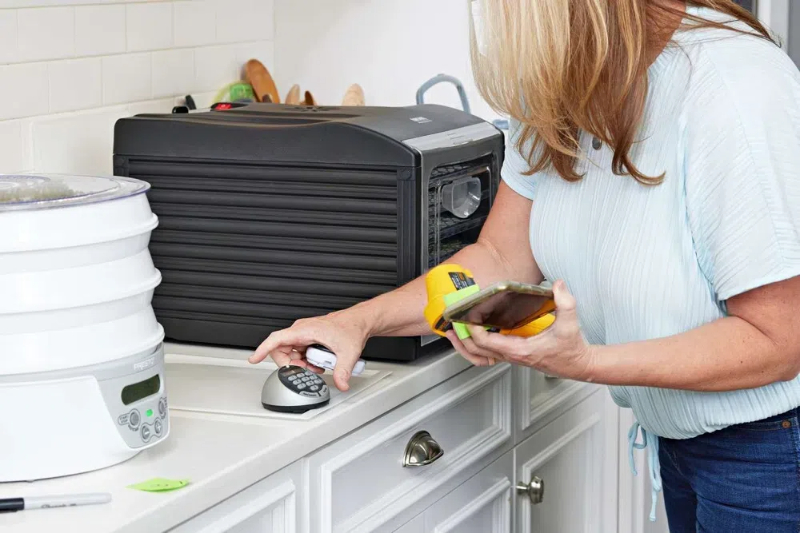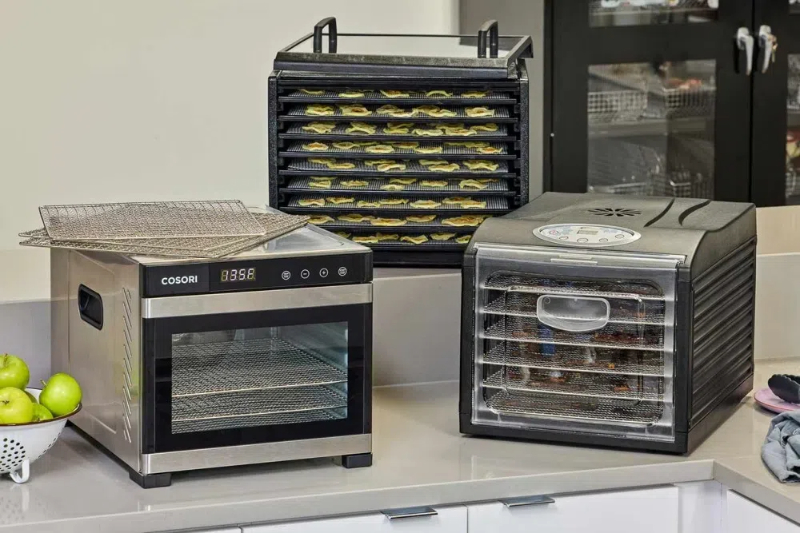
Content Menu
● Introduction
● What is a Cabinet Type Dehydrator?
● Benefit 1: Large Capacity and Space-Saving Solutions
● Benefit 2: Precise Temperature Control
● Benefit 3: Uniform Drying
● Benefit 4: Versatility in Food Processing
● Benefit 5: Energy Efficiency
● Benefit 6: Reduction of Food Waste
● Benefit 7: Enhanced Food Safety
● Benefit 8: Extended Shelf Life
● Benefit 9: Easy to Use and Maintain
● Benefit 10: Prep for Emergencies
● Practical Tips for Using a Cabinet Type Dehydrator
● Conclusion
● FAQ: Frequently Asked Questions About Cabinet Type Dehydrators
>> 1. What types of food can be dried in a cabinet dehydrator?
>> 2. How do I clean a cabinet dehydrator?
>> 3. What is the ideal temperature for dehydrating different types of food?
>> 4. How long does it take to dehydrate food in a cabinet dehydrator?
>> 5. Are cabinet dehydrators energy-efficient?
● Citations:
Introduction
As a Chinese food dehydrator manufacturing factory providing OEM services, it's crucial to understand the advantages of different types of dehydrators. Among these, cabinet type dehydrators stand out due to their efficiency, capacity, and versatility. This article explores the top 10 benefits of using a cabinet type dehydrator, highlighting why they are an excellent choice for both commercial and industrial applications. Knowing these benefits enables us to better serve our partners by offering superior products tailored to their needs.

What is a Cabinet Type Dehydrator?
A cabinet type dehydrator, also known as a shelf style dehydrator, is a large, enclosed appliance with multiple shelves or trays inside. These dehydrators use a heating element and a fan to circulate warm air evenly throughout the cabinet, removing moisture from food items placed on the shelves. Unlike smaller, stackable dehydrators, cabinet models offer greater capacity and control, making them ideal for large-scale food processing. They are designed for continuous operation, often incorporating robust components to withstand the demands of commercial use.
Benefit 1: Large Capacity and Space-Saving Solutions
One of the primary advantages of cabinet dehydrators is their large capacity. These units can hold numerous trays, allowing you to dehydrate large batches of food simultaneously. This is particularly beneficial for commercial operations that need to process significant quantities of ingredients quickly. For instance, a large-scale fruit processing plant can dehydrate hundreds of kilograms of apple slices, mangoes, or berries in a single run.
Furthermore, despite their high capacity, cabinet dehydrators provide space-saving solutions. Their vertical design maximizes the use of floor space, making them suitable for facilities with limited room. In a busy production environment where every square meter counts, the compact footprint of a cabinet dehydrator is a significant advantage.
Benefit 2: Precise Temperature Control
Precise temperature control is essential for effective dehydration. Cabinet dehydrators typically come with sophisticated temperature control systems that allow you to set and maintain the ideal temperature for different types of food. This ensures that the food is dried evenly and thoroughly without overheating or scorching. For example, herbs like basil and rosemary require lower temperatures (around 95-105°F) to preserve their volatile oils and flavors, while meats need higher temperatures (155-165°F) to ensure they are safe to consume.
The ability to control temperature precisely also helps preserve the nutritional value, flavor, and color of the dehydrated products. Overheating can destroy vitamins and enzymes, while insufficient heat can lead to spoilage. Precise control ensures optimal results.
Benefit 3: Uniform Drying
Uniform drying is critical for producing high-quality dehydrated foods. Cabinet dehydrators are designed to circulate air evenly across all trays, ensuring that each piece of food receives the same amount of heat and airflow. This prevents some items from being over-dried while others remain moist. The result is a consistent, high-quality product with a longer shelf life. This is achieved through strategically placed fans and vents that distribute air evenly throughout the cabinet.
In contrast, less sophisticated dehydrators may have hot spots or uneven airflow, leading to inconsistent drying. Cabinet dehydrators eliminate these issues, providing a uniform product every time.

Benefit 4: Versatility in Food Processing
Cabinet dehydrators are incredibly versatile and can be used to dry a wide range of food items. From fruits and vegetables to meats and herbs, these dehydrators can handle it all. You can dehydrate apples, bananas, strawberries, carrots, tomatoes, beef jerky, chicken, and various herbs and spices. Additionally, cabinet dehydrators can be used for other purposes, such as making yogurt or drying flowers. Some models also offer specialized settings for specific types of food, further enhancing their versatility.
This versatility makes them a valuable asset for businesses looking to diversify their product offerings. A company that initially focuses on dehydrated fruits can easily expand into dehydrated meats or herbs without needing additional equipment.
Benefit 5: Energy Efficiency
Modern cabinet dehydrators are designed with energy efficiency in mind. They often feature insulated walls and doors to minimize heat loss, as well as efficient heating and cooling components. Insulation helps maintain the internal temperature, reducing the amount of energy needed to keep the dehydrator running. High-efficiency heating elements and fans also contribute to energy savings.
Some models also come with advanced control systems that optimize energy consumption based on the moisture content of the food. These systems automatically adjust the temperature and airflow to minimize energy usage while still ensuring effective dehydration. This can lead to significant cost savings over time, especially for businesses that use dehydrators frequently.
Benefit 6: Reduction of Food Waste
Reducing food waste is a growing concern for businesses and consumers alike. Cabinet dehydrators can help address this issue by preserving excess food that would otherwise spoil. By dehydrating fruits, vegetables, and meats before they go bad, you can extend their shelf life and reduce the amount of food that ends up in the trash. For example, overripe bananas can be dehydrated into banana chips, and surplus tomatoes can be transformed into sun-dried tomatoes.
This not only saves money but also helps promote sustainability. Businesses can reduce their waste disposal costs and minimize their environmental impact by dehydrating excess produce. Consumers can also save money and reduce their carbon footprint by dehydrating food that would otherwise go to waste.
Benefit 7: Enhanced Food Safety
Food safety is paramount in the food processing industry. Cabinet dehydrators help ensure food safety by removing moisture, which inhibits the growth of bacteria, mold, and other microorganisms. Microorganisms thrive in moist environments, so removing moisture is a crucial step in preserving food and preventing spoilage.
The precise temperature control and uniform drying capabilities of these dehydrators further minimize the risk of contamination. Proper temperature control ensures that the food is heated to a safe temperature, killing any harmful bacteria. Uniform drying prevents pockets of moisture where bacteria could grow. Additionally, many cabinet dehydrators are made from stainless steel, which is easy to clean and sanitize. Stainless steel is non-porous, making it difficult for bacteria to adhere to the surface.
Benefit 8: Extended Shelf Life
One of the most significant benefits of using a cabinet dehydrator is the extended shelf life it provides for food products. Dehydrated foods can last for months or even years without spoiling, making them ideal for long-term storage and distribution. This is particularly valuable for businesses that need to ship products over long distances or store them for extended periods. Dehydrated fruits, vegetables, and meats can be stored in airtight containers or vacuum-sealed bags for optimal shelf life.
For example, dehydrated apples can last up to a year when stored properly, while dehydrated beef jerky can last for several months. This extended shelf life reduces the risk of spoilage and allows businesses to manage their inventory more efficiently.
Benefit 9: Easy to Use and Maintain
Despite their advanced features, cabinet dehydrators are generally easy to use and maintain. Most models come with user-friendly control panels and straightforward operating instructions. The controls are typically intuitive, allowing users to easily set the temperature, timer, and other settings.
Cleaning is also a breeze, thanks to removable trays and stainless-steel interiors. Regular maintenance typically involves wiping down the interior, cleaning the trays, and checking the heating and cooling components. Some models also have self-cleaning functions that further simplify maintenance.
Benefit 10: Prep for Emergencies
Dehydrating food is also a great way to prep for emergencies. Dehydrated food is lightweight, compact, and has a long shelf life, making it ideal for emergency food supplies. In emergency situations, access to fresh food may be limited, making dehydrated food a valuable resource.
A cabinet dehydrator allows you to prepare a large quantity of emergency food quickly and efficiently. You can dehydrate fruits, vegetables, meats, and even grains to create a well-rounded emergency food supply.
Practical Tips for Using a Cabinet Type Dehydrator
-Pre-treat foods: Blanching vegetables or marinating meats before dehydrating can improve their flavor and texture.
-Cut food into uniform sizes: This ensures even drying.
-Arrange food in a single layer: Avoid overcrowding the trays.
-Monitor moisture content: Check the food regularly to ensure it is properly dried.
-Store dehydrated food properly: Use airtight containers or vacuum-sealed bags.
Conclusion
In conclusion, cabinet type dehydrators offer numerous benefits for businesses and individuals alike. From their large capacity and precise temperature control to their uniform drying capabilities and energy efficiency, these dehydrators are an excellent investment for anyone looking to preserve food, reduce waste, and enhance food safety. As a Chinese food dehydrator manufacturing factory, understanding these benefits will enable you to better serve your OEM clients and provide them with top-quality products. By highlighting these advantages, we can help our partners make informed decisions and choose the best dehydrator for their specific needs.

FAQ: Frequently Asked Questions About Cabinet Type Dehydrators
1. What types of food can be dried in a cabinet dehydrator?
Cabinet dehydrators are versatile and can dry a wide range of foods, including fruits, vegetables, meats, herbs, and even flowers. They are also suitable for making yogurt. The key is to understand the specific drying requirements for each type of food and adjust the temperature and drying time accordingly.
2. How do I clean a cabinet dehydrator?
Cleaning a cabinet dehydrator is usually simple. Most models have removable trays and stainless-steel interiors, making them easy to wipe down. Regular cleaning involves removing any food debris, washing the trays with soap and water, and wiping down the interior with a damp cloth. Avoid using abrasive cleaners, as they can damage the stainless-steel surface.
3. What is the ideal temperature for dehydrating different types of food?
The ideal temperature for dehydrating food varies depending on the type of food. Generally, fruits and vegetables are dried at lower temperatures (around 130-140°F), while meats require higher temperatures (around 155-165°F) to ensure food safety. Always refer to a reliable dehydration guide for specific temperature recommendations. Using a food thermometer can help you monitor the internal temperature of the food during the dehydration process.
4. How long does it take to dehydrate food in a cabinet dehydrator?
The dehydration time depends on the type of food, its thickness, and the dehydrator's temperature. It can take anywhere from a few hours to several days to fully dehydrate food. Monitoring the food's moisture content and adjusting the drying time accordingly is essential. Check the food regularly and remove it when it is properly dried.
5. Are cabinet dehydrators energy-efficient?
Modern cabinet dehydrators are designed with energy efficiency in mind. They often have insulated walls and doors to minimize heat loss and advanced control systems to optimize energy consumption. Look for models with energy-saving features such as automatic shut-off and adjustable temperature settings.
Citations:
[1] https://www.bestbuy.com/discover-learn/10-reasons-to-buy-a-food-dehydrator/pcmcat1634332391134
[2] https://patents.google.com/patent/CN110207480A/zh
[3] https://www.seriouseats.com/best-food-dehydrators-5216308
[4] https://patents.google.com/patent/CN1110593C/zh
[5] https://www.backcountrypaleo.com/choosing-a-dehydrator/
[6] https://shop.howlifeusa.com/zh/washing-machine/
[7] https://www.ike.cn/precious-cabinet-dryer-for-food-middle-pump-ike.html
[8] https://www.mitsubishielectric.com.hk/products/Dehumidifier











